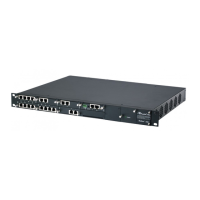User's Manual 1024 Document #: LTRT-10532
Mediant 500L Gateway & E-SBC
Parameter Description
Note: If the functionality is configured for a specific profile, the
settings of this global parameter is ignored for calls associated with
the profile.
Gold QoS
gold-qos
[GoldServiceClassDiffServ]
Defines the DiffServ value for the Gold CoS content (Streaming
applications).
The valid range is 0 to 63. The default is 26.
Bronze QoS
bronze-qos
[BronzeServiceClassDiffServ]
Defines the DiffServ value for the Bronze CoS content (OAMP
applications).
The valid range is 0 to 63. The default is 10.
69.2.5 NAT and STUN Parameters
The Network Address Translation (NAT) parameters are described in the table below.
Table 69-13: NAT Parameters
Parameter Description
NAT Parameters
NAT Traversal
configure voip > media
settings > disable-NAT-
traversal
[NATMode]
Enables the NAT traversal feature for media when the device
communicates with UAs located behind NAT.
[0] Enable NAT Option = NAT traversal is performed only if the UA
is located behind NAT:
UA behind NAT: The device sends the media packets to the IP
address:port obtained from the source address of the first
media packet received from the UA.
UA not behind NAT: The device sends the packets to the IP
address:port specified in the SDP 'c=' line (Connection) of the
first received SIP message.
Note: If the SIP session is established (ACK) and the device (not
the UA) sends the first packet, it sends it to the address obtained
from the SIP message and only after the device receives the first
packet from the UA does it determine whether the UA is behind
NAT.
[1] Disable NAT = (Default) The device considers the UA as not
located behind NAT and sends media packets to the UA using the
IP address:port specified in the SDP 'c=' line (Connection) of the
first received SIP message.
[2] Force NAT = The device always considers the UA as behind
NAT and sends the media packets to the IP address:port obtained
from the source address of the first media packet received from the
UA. The device only sends packets to the UA after it receives the
first packet from the UA (to obtain the IP address).
[3] NAT By Signaling = The device identifies whether or not the UA
is located behind NAT based on the SIP signaling. The device
assumes that if signaling is behind NAT that the media is also
behind NAT, and vice versa. If located behind NAT, the device
sends media as described in option [2] Force NAT; if not behind
NAT, the device sends media as described in option [1] Disable
NAT. This option is applicable only to SBC calls. If the parameter is
configured to this option, Gateway calls use option [0] Enable NAT

